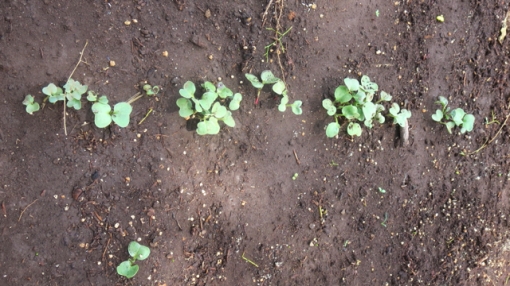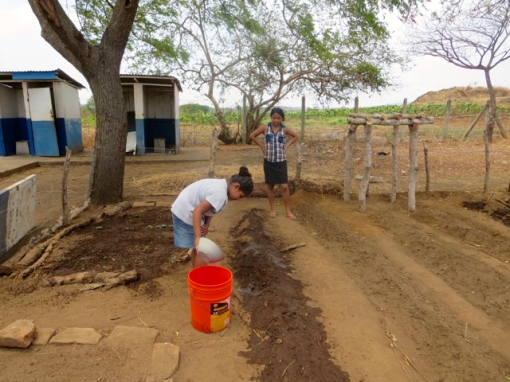Wednesday I spent the morning on the back of a motorcycle driven by Fanny Mercado, a graduate of the UNAN Agroecology program who is working for SosteNica‘s EcoCentro and is in charge of helping six local schools create and take care of educational gardens.

We hit some traffic along the route to Chilama.
When we conducted a survey at the end of a project promoting family gardens a few years ago, one of the most common reasons that crops failed was because children or pets destroyed them. Families here often live several generations in one house, with a small yard, and space to run around is also valuable! When we stopped by to check on the gardens, we always made sure to involve the youngest family members so they learned to understand and respect the plants. But not all kids have that opportunity at home – so school gardens are another place where they can learn to value gardening.
When Fanny visits the schools weekday mornings, a few students are selected to work with her each day so that they get to integrate into the work. Sometime if there is an activity that is appropriate for all the children, the teacher will invite Fanny into the classroom. When we arrived at each school, the kids were excited to see her, and clearly saw the opportunity to work in the garden as a prized experience.

Fanny works with a group of students to start a compost pile in the corner of the school yard next to the garden. In this school, they are close enough to the urban center to have potable water (with water pressure!) from the city.
The drought right now at the end of the dry season is very serious. Even though the students take on the chore of watering the gardens twice a day, the gardens in full sun have had very low germination rates. At some schools, there are only artisanal wells and no water pressure, so the children draw water by hand and walk it to the garden to water. Now is the time to start seeds in the shade – tomatoes, beets, peppers, onions – so that they can be transplanted in a few weeks when the rains start.

Fanny starts the hard work of cranking the wheel to bring water up from the well to water the garden in Chilama.
At the first garden we went to the importance of a fence became incredibly obvious. The elementary school in the village of Silvio Mayorga is in the middle of a group of houses. The barbed wire fences don’t keep the chickens from the surrounding families out of the schoolyard. Just outside the chain link fence surrounding the garden, the dirt was filled with the marks of chicken feet scratching and digging for bugs or sprouted seeds. Fanny told me that before there was a fence, they planted squash seeds in the garden. A few days later a neighbor’s pig escaped and spent a lovely evening digging himself a cool spot to spend the night in the damp soil of the garden. So this time they waited until the fence was built to plant any seeds.

Radishes!
At the school in the village of Valle de Jesús a boy ran out to greet us. “What are we going to plant! I want to plant seeds!” But the fence there isn’t finished yet. A group of parents had come over the weekend and put posts up, but it wasn’t finished yet. He was disappointed, so before we left Fanny pulled out her seed packets and gave him a few watermelon seeds to plant at his house. Whether they sprout or not, it’s great to see such enthusiasm here for gardening.

Two young sisters in Chilama carefully water the beds with a bowl to not disturb the sprouting seeds. The stand to the right will hold a tank of water to operate a small drip irrigation system.
April 28, 2016 at 6:59 am
Hi Rachel, It’s great to visit the schools with you. What does it take to get parents involved in the school gardens? How engaged are the teachers?
April 28, 2016 at 9:22 am
The teachers seem to be happy to support the garden and send small groups to work with Fanny, but from what I can tell they aren’t integrating the garden into their other classes, like math or science. I’ve been talking with the center about how to encourage them to do that. The parents seem to be helping tremendously – they are doing all the work of building fences and irrigation systems.
April 28, 2016 at 4:16 am
this is inspiring.. really nice
regards
http://yourwellwisherprogram.wordpress.com
April 27, 2016 at 11:15 pm
This is great! I love to hear about the enthusiasm of the kids for planting seeds. You all are doing that, literally and figuratively. Lovely.
April 28, 2016 at 9:23 am
Thanks Abby!
April 27, 2016 at 5:09 pm
Have you worked with the Biointensive people in Nicaragua, Michael Richardson and John Wyss? We work with villages near Chacocente, Sta Teresa, and have just started a biointensive program , training a man to do this method and he will train others.
April 27, 2016 at 5:11 pm
Yes Sally! I was a founding member of the board of directors for the Biointensive center with John and Michael when I lived in Nicaragua. They are doing great work – congratulations on starting your program!